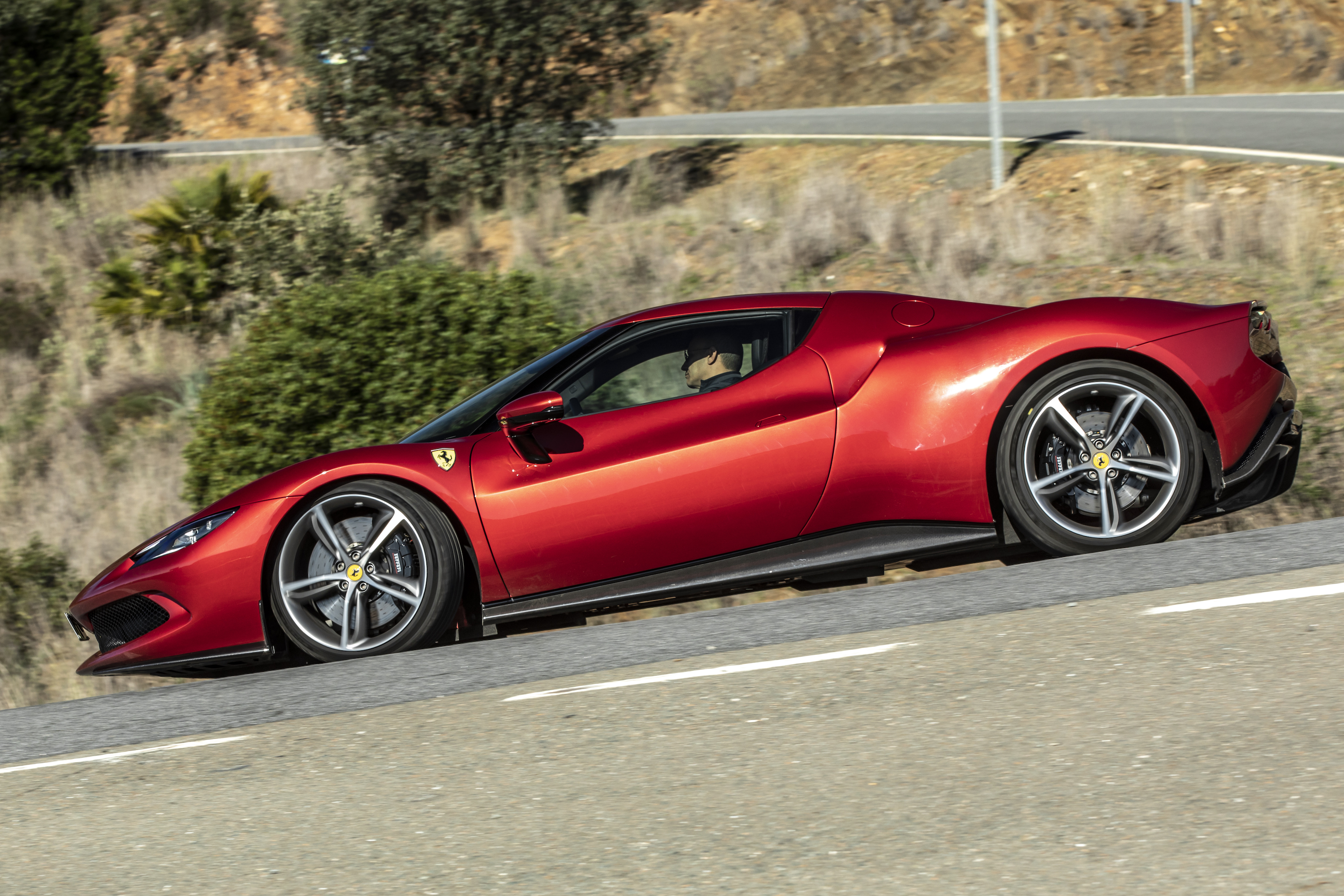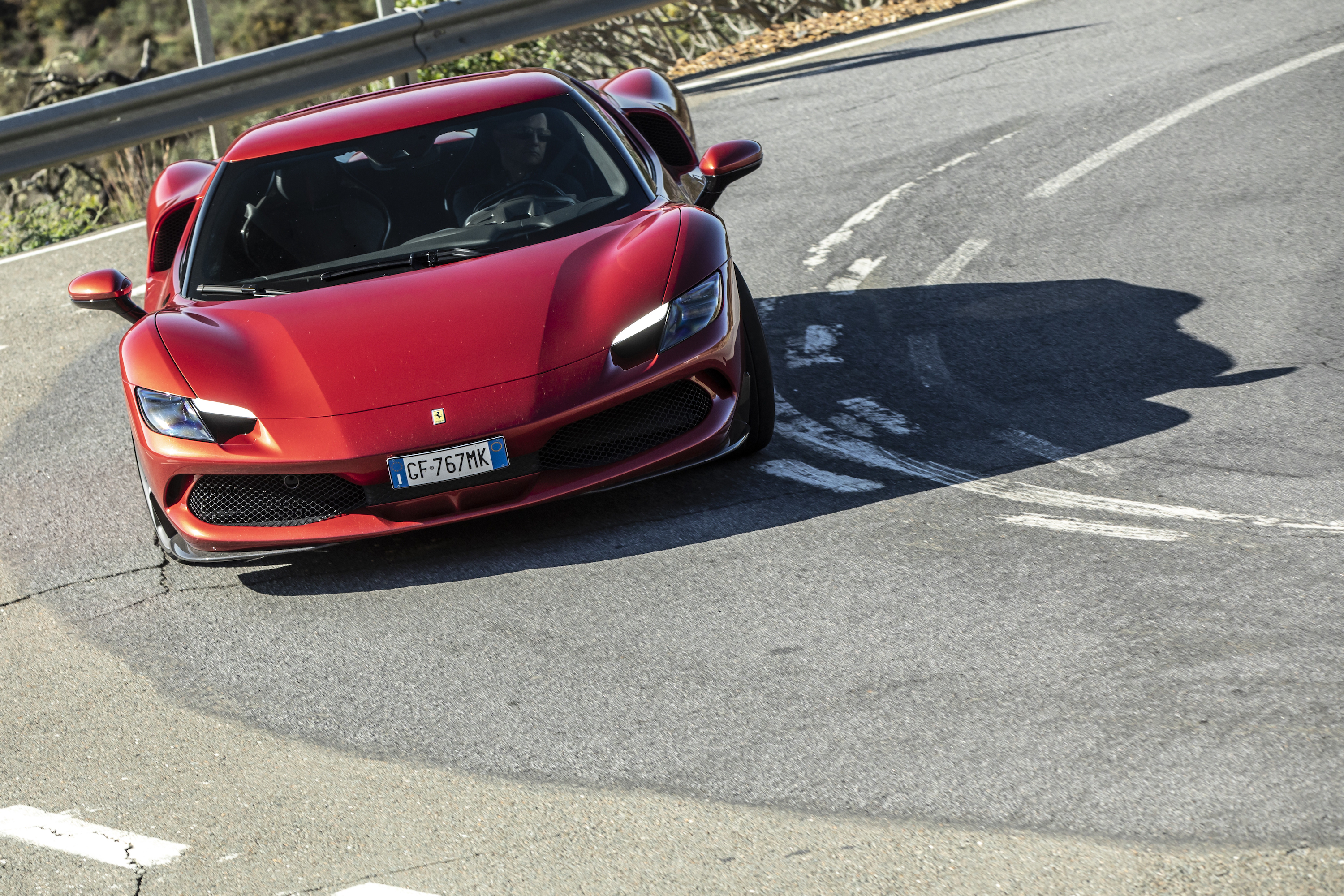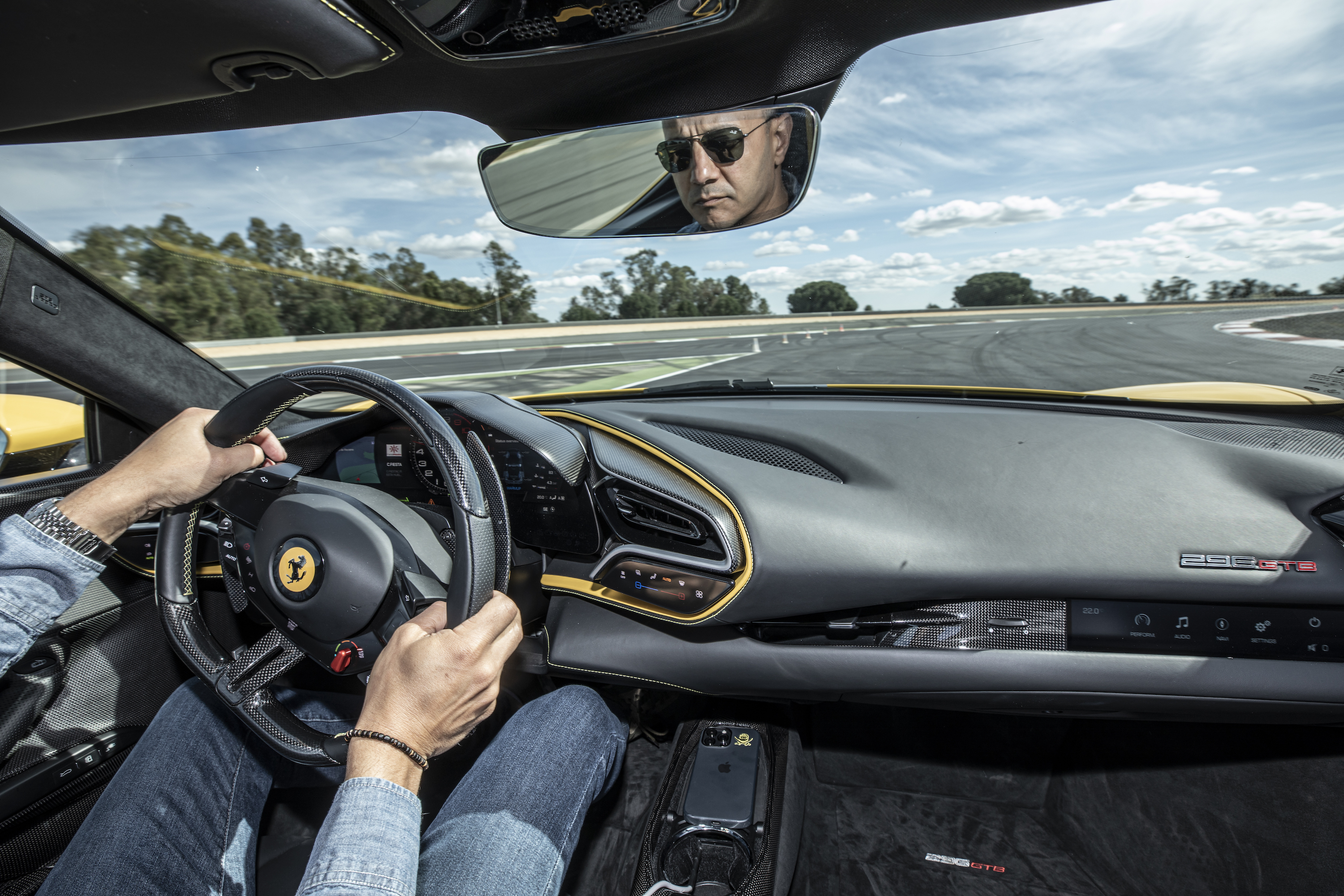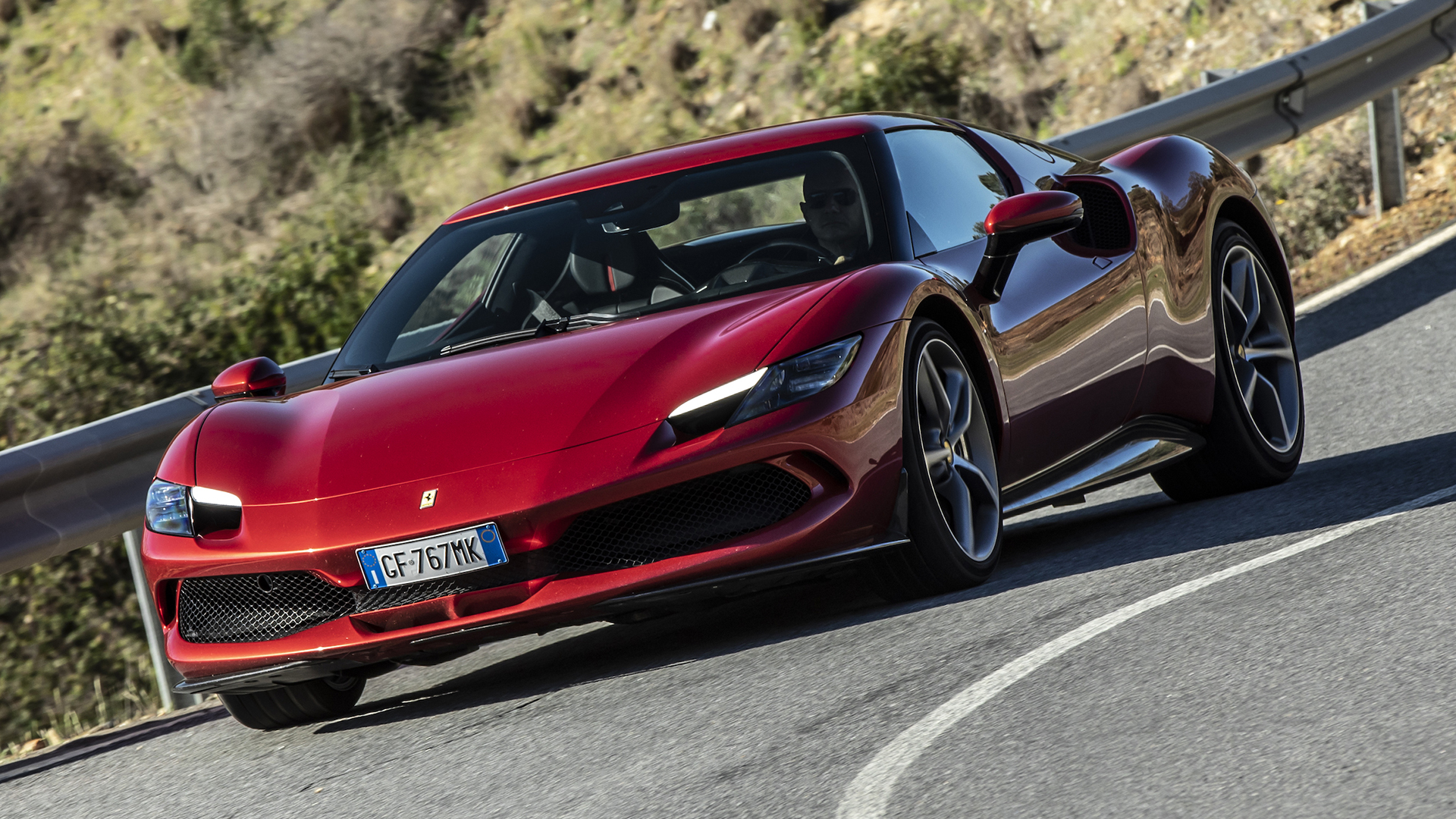Old man Enzo Ferrari was a large man who stuffed large engines in punchy packages. In 1947, he squeezed a V12 into the first Ferrari despite the two-seater’s Cinquecento-sized footprint. Today, Ferrari’s ghost lingers in saucy strains like the front-engine, rear-drive, V12-powered 812 even though the de facto flagship right now is the V8 hybrid-powered, all-wheel-drive SF90. But even stranger times are ahead because the new 2022 Ferrari 296 GTB gets its power from (gasp) a V6 plug-hybrid powertrain.
This is a big deal for a number of reasons. High-revving 12-cylinders were long considered the pinnacle of the Maranello microcosm, casting smaller engines as second-class vehicular citizens. Ferrari’s disdain for newness was also evidenced by his famous desire to “fix” poor aerodynamics with good old-fashioned horsepower. When the Modena factory condescended to producing V6s decades later, the House of Ferrari either badged them as “Dinos” (positioning them as entry-level models) or quietly supplied them to brands like Lancia and Maserati.




Thankfully, those worried about this newest Ferrari potentially being Lancia-ed or Maserati-fied have nothing to fret about. The hybridizing and downsizing make the 296 no less a Ferrari. It’s every bit as worthy of the prancing horse on its nose as its V8 and V12-powered siblings are. Did you expect anything less from Maranello?
2022 Ferrari 296 GTB Specs
- Base price: $317,986 ($5,000 destination fee included)
- Powertrain: 3.0-liter twin-turbo V6 plug-in hybrid | 8-speed dual-clutch | rear-wheel drive
- Horsepower: 818 @ 8,000 rpm
- Torque: 546 lb-ft @ 6,250 rpm
- Curb weight: 3,527 pounds
- Seating capacity: 2
- 0-60: 2.7 seconds (est.)
- Top speed: 205-plus mph
- Cargo volume: NA
- EPA fuel economy: TBA
- Quick take: A rambunctious hybrid supercar that would have done Enzo Ferrari proud.
- Rating: 9/10
Modern Times
The first road-going Ferrari to pack a six-cylinder in nearly 50 years, the 296 inverts the brand’s legacy structure by cutting cylinders, adding electrification, and positioning itself above several V8 models. Of course, Ferrari is not alone: the blokes in Woking are making similar moves with the upcoming McLaren Artura—not to mention a slew of other sports car manufacturers resorting to the downsize-and-upmarket tactic in order to meet emissions and CO2 regulations while also satisfying the hearts and minds of deep-pocketed buyers.


The 296’s engine is all-new, using a 120-degree configuration that drops the car’s center of gravity by 10mm and sheds 66 pounds over the F8 Tributo’s mill. The hot-vee setup uses smaller turbos spinning at up to 180,000 rpm, claiming the highest specific resulting output of any roadgoing Ferrari engine ever: 217 horsepower per liter. Augmenting the 653 hp V6 is another 164 hp from a 7.45 kWh battery driving a rear motor derived and adapted from the SF90, bringing the 296’s grand total to a (very grand) 818 hp. For a bit of context, consider that this mid-range ‘Rari outmuscles F1 cars from just a few years ago. How ya like them apples, Enzo?
The Roma brought prettiness back into Ferrari’s design language, and the 296 continues that trajectory with a delicately pointed, purposeful take on the mid-engine Berlinetta paradigm. The tightrope between clean, uncluttered expanses of sheet metal and complex curves is executed deftly with a sharp nose, an hourglass waist, and haunches that nod to the slinky 1960s-era 250LM. Nestled between the flying buttresses is a gorgeously contoured glass engine cover that complements the haunches, displaying the mill’s Inconel surfaces like an H.R. Giger sculpture; the $39,500 Assetto Fiorano package uses a lighter Lexan material. The sheen of metallic finishes under glass offers a visual reassurance to traditionalists, though a—pardon the pun—shock of orange high-voltage cables betrays the electrified underpinnings.
As much as the view reveals the complex workings beneath, the tail resolves in a beautiful merging of tapered forms that honor the mechanical bits: the centrally positioned exhaust, the extraction points for the active aero and low-key spoiler, and a diffuser that helps keep the sticky parts down. The fact that the taillamps blend in almost invisibly speaks volumes to the efforts design boss Flavio Manzoni exerted to maintain a balance between elegance and purpose. A chorus of naysayers may have dismissed its online debut (thanks, internet!), but in the flesh, the 296 is a stone-cold stunner whose design feels lithe, purposeful, and just pretty enough without verging on preciousness.





Ways and (Golden) Means
The 296 is deceptively small, sitting nearly five inches lower than a Porsche 911 Turbo and just three inches longer than the rear-engined Stuttgart sled. Curb weight without a 165-pound driver is a claimed 3,527 pounds, undercutting the Turbo’s 3,635-pound mass despite complex hybrid and battery components—though it’s out-skinnied by the McLaren Artura’s anticipated 3,300-pound weight. You wouldn’t know it from the curvy bodywork, but even though it isn’t slapped with a picnic table-sized rear wing (I’m looking at you, Lambo), the 296’s discreet active aero elements can create up to 800 pounds of downforce at 160 mph. It also has a wheelbase that’s some two inches shorter than the SF90’s.
Climb inside and the cabin feels sparse, sleek, and unencumbered by conventional architecture. There are no bulky protrusions or a center stack packed with switchgear, just thin carbon fiber and leather seats facing an airy swath of leather-wrapped dashboard and a big windscreen with an expansive view of the road ahead. It wouldn’t be the 21st century without a digitized instrument cluster, and the 296 goes the whole hog on the zeros and ones with a wraparound screen that presents a convincing rendition of Ferrari’s familiar yellow tachometer front and center. The panel can be modded with various bits of data flanking the tach, or a full view of the navigation map with a small inset depicting speed and gear position. Many details are well thought-out, like the oddly satisfying rectangular space where the key fob, finished with an exquisite cloisonné prancing horse, fits perfectly. However, some out-of-the-way bits, like the thermoplastic trim on the door, require a pricey carbon package upgrade to keep the 296 feeling as baller as its MSRP suggests it is.
As much as most of us love the jewelry of physical instrument needles, the curved screen fits the purpose here without feeling gimmicky. On the other hand, the haptic controls disappoint. Yes, the Manettino remains wonderfully mechanical, with a just-clicky-enough feel as it ticks into Wet, Sport, Race, CT Off (which loosens stability control and disables traction control), or all-off settings. But on the left side of the redesigned steering wheel is what Ferrari calls an eManettino. The backlit display disappears into a black panel when not in use, and activates eDrive, Hybrid, Performance, or Qualify settings when activated by touch. Equally upsetting is the replacement of the big, red, satisfyingly spring-loaded engine start button with a haptic surface at the 6 o’clock position, as well as a haptic voice command button that can easily get accidentally triggered when tapping the left turn signal. Such are the tradeoffs when a storied Italian brand stays aggressively on top of its future-friendly hustle.




Sound and Fury
If you’re bummed that pressing Engine Start produces no sound other than the inscrutable whirs and chimes of electronics systems firing up, that disappointment will be short-lived: Though the Ferrari 296 always starts in Hybrid mode, switching to a more aggressive setting ignites the fuel-burning portion of the drivetrain and fills the cabin with the loud, gutturally appealing sounds of internal combustion.
The V6’s 120-degree firing order emits a smooth hum of exhaust which pulses its way through two symmetrical pipes leading to the centrally positioned outlet. If the engine sounds unusually soulful, credit the so-called hot tube which routes air intake sonics through a membrane, allowing those resonant frequencies to enter the cabin through the rear bulkhead. The sound outside is also evocative at idle and stirring at speed, though in a less raucous way than Ferrari’s usual V8s and V12s. Especially when roaring down the long straight at the Monteblanco Circuit near Sevilla, Spain, the engine’s 8,500-rpm wail is accompanied by a surprisingly loud whoosh of air. Yet, it seems the aural effect in the cabin, though enhanced naturally and not digitally, is more emphatic inside than outside the vehicle.
Nestle into the thin-shelled driver’s seat, and there’s a surprising amount of comfort despite its relative lack of adjustability. Though redesigned, the steering wheel feels familiar to those already acquainted with the prancing horse brand. A load of buttons and switches are packed into the wheel á la Formula 1, including high beams (tap the left backside), wiper pulse (tap the right backside), turn signals on either side, as well as the aforementioned drive mode settings, Manettino dial, and various and sundry items including haptic quadrants for menu settings. The touch-sensitive bits take a bit of practice to get used to, and never seem to work quite right; I found myself swiping, then double swiping before realizing the system went too far, which required me to start the process again from scratch.
Once past the maddening haptic hiccups, the 296 hits you with a fortune of mechanical delights. Yes, you can cruise for 15 miles at up to 83 mph in electric mode, which is predictably quiet yet not-all-that quick. But leaning on a combination of gas and electricity brings out the secret sauce that makes Ferraris feel like nothing else on the planet: This thing is alive.

Steering into a corner produces just enough lightness and accuracy to put the onus on driver skill for aim of precision, but it’s not twitchy like past Ferraris—particularly, the notoriously edgy 458, the slightly more manageable 488, or the still-sharp-but-more-refined F8 Tributo. For the record, the 296 claims the same steering ratio as the F8 Tributo, though dialed in with slightly higher effort. The electromechanical setup is still remarkably light but adds a touch of heft while delivering outstanding feel. Ferrari credits hardware improvements to its so-called Side Slip Control system, which communicates with the electronic steering system to estimate available grip and create the requisite amount of feedback. Whatever black art is happening behind the scenes, the feeling behind the wheel is magic, with steering that feels lively, accurate, and chatty about what’s happening with the road surface below.
Accelerate hard, and the 296 merges hydrocarbons and electrons for a linear buildup of power that escalates dramatically as the tachometer reaches the 8,500-rpm limit. This isn’t the peaky, high-end punch of a Ferrari flat-crank V8 or the ethereal crescendo of a revvy V12; the union of gas and electric creates a torque fill at lower rpms that merges with a swell in mid-range power and an eager continuation towards redline. While the eight-speed dual-clutch gearbox is capable of executing quick and flawlessly smooth shifts, the automatic shift strategy is weirdly conservative, even in the most aggressive settings. In Qualify mode with CT Off, the transmission still upshifts unusually early. To squeeze the most out of the drivetrain, it’s best to tap either of the fixed carbon paddles alongside the steering wheel, and/or switch into full manual mode via the small toggle between the front seats.
On the immaculately paved roads cutting through the Spanish countryside, the Michelin Pilot Sport 4 Ses lay down the power with reassuring grip, especially in Race mode, which manages to keep the tail end in check imperceptibly through traction control. Nudge the nose into a turn, and the chassis responds fluidly and intuitively, with a quick and easy rotation that lacks any of the disconcerting jerks or oversteer sometimes associated with mid-engine configurations. There’s only 40.5 percent of the vehicle’s weight on the front wheels, which makes the pointy end feel nimble and eager. Pedal-feel from the brake-by-wire stoppers is similarly intuitive, providing no hint of artificiality or weird feedback.


Changing direction feels so organic that it becomes addictive; corner after corner, the 296 pleads for quicker entry speeds and higher G forces. Looking back at GoPro footage from the road drive reveals an eye-opening pace without any of the white-knuckle anxiety you might expect at these bonkers speeds, largely thanks to the amount of communication expressed through the steering wheel, accelerator, and brake pedal. With so much sensation flowing through the three, there’s never a question of how the tires are addressing the road.
The 296 manages to be thrilling to drive at higher speeds, with the unusual ability to also provide enough feedback that lower speeds are also deeply enjoyable (though it takes remarkable willpower to drive within legal limits). This is a rare club to get into, whose members include the Mazda Miata, Lotus Elise, and Alfa Romeo 4C; the 296 feels like a genetic mishmash of those little bruisers on ‘roids, infused with a touch of trickle-down DNA from the fearsome SF90.
Checkered Flag
Our afternoon session at Monteblanco Circuit consisted of chasing Ferrari’s pro driver in an Assetto Fiorano-equipped 296 for literally one session, a brief time which is somewhat comprehensible given that Michelin estimates it’ll be replacing around 300 of its exotic Sport Cup 2R for this global media launch. Considering what I know about Ferrari’s drive modes and the basics of what the 296 can do from my road drive, I set the powertrain mode to Qualify and spent roughly three corners in Race mode before I realized I couldn’t muster enough drive coming out of corners to keep up with the pace car without dialing the Mannettino to CT Off, which further loosened the electronic reigns and switched traction control off.


What started as a fast, precise, draw-within-the-lines experience instantly transformed to a rowdy, tail-out, countersteering romp. You wouldn’t expect anything less from an 818-hp, mid-engine, rear-drive car equipped with competition-ready suspension hardware from Multimatic. But then again, it’s easy to forget how much power it’s capable of in milder settings because the electronics are so good at limiting output when needed without making it feel choked or underpowered.
Unleashed and in CT Off mode, I was able to hang close enough to the pace car for the driver to yell “Distance, distance!” over the radio, in order to keep my car from getting pelted by debris from the dirty track. I was also able to notice that, despite the car’s outstanding powertrain and chassis tuning, there’s a slight perception of rearward weight transfer that comes from a combination of the 3,527-pound curb weight and having 59.5 percent of the mass sitting on the rear axle. It was only perceptible when driving well beyond the car’s limits, which are remarkably high to begin with. But it’s there.
While last year’s drive in the SF90 at Fiorano revealed an unreal amount of rotational ease and corner exit power thanks to the car’s torque vectoring front motors, the 296 felt a bit livelier and more playful while still producing enough thrust to hit an indicated 175 mph on the straight at Monteblanco. Jam the brakes, and ginormous 398mm Brembo carbon ceramics create a remarkable amount of stopping power, with added stability coming from the active aero and e-diff.



The Quiet Part Out Loud
Stepping away from a day behind the wheel of the Ferrari 296 GTB reinforced everything I suspected about the brand’s first V6 since the Dino but might have been afraid to say out loud. Endowed with the assistance of an electric motor, it never felt wanting for torque or horsepower. Critically, it was also neither sonically nor dynamically challenged and offered delightful steering, communicative handling, and enough suspension compliance to make it a viably comfortable everyday driver.
Aficionados (or supercilious snobs, depending on your viewpoint) who demand the definitive Ferrari V8 or V12 sound experience will likely nitpick over the 296. But that doesn’t mean the V6 hybrid experience is inherently flawed; it’s just different from everything that came before it. And with a starting MSRP north of $300,000, it’s certainly positioned as a special sort of Ferrari. While this engine configuration and those numbers might cause il Commendatore to roll in his grave, old man Enzo Ferrari might be assuaged by one critical metric: the 296 GTB beats the V8-powered Pista by half a second around the Fiorano track, proving at least to the empirically obsessed that sometimes less is, indeed, more.
One thing the numbers don’t capture, though: the simple yet indulgent pleasures of driving a short wheelbase, high horsepower car in anger. Some things will never change.




Basem Wasef is a motorcycle and automotive journalist. He’s written for Wired, Men’s Journal, and Automobile and resides in Los Angeles.
Got a tip? Send a note to tips@thedrive.com.
